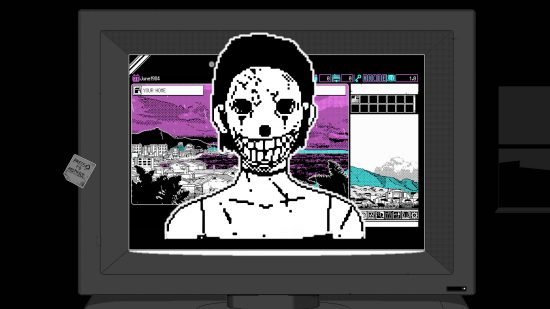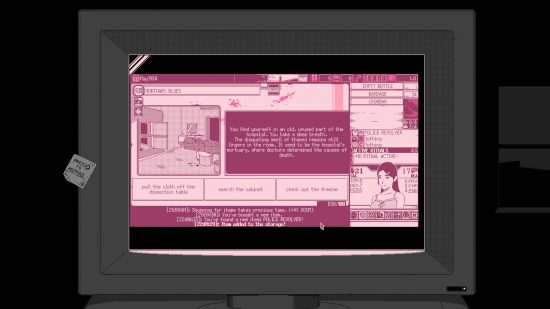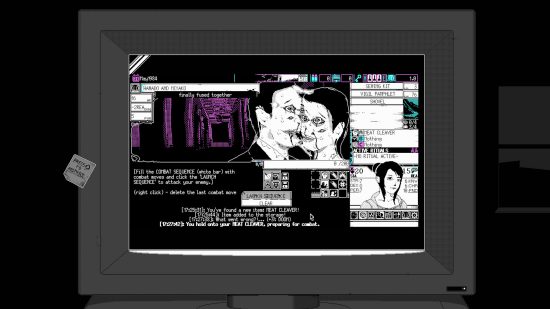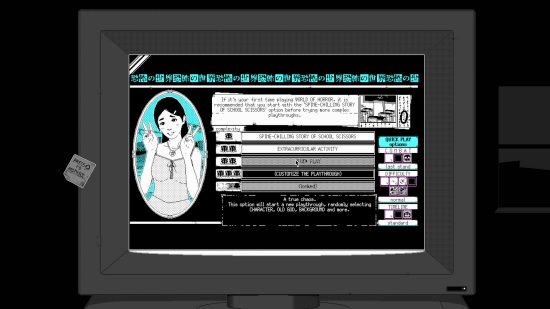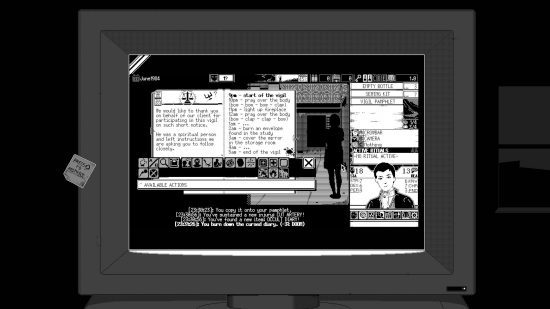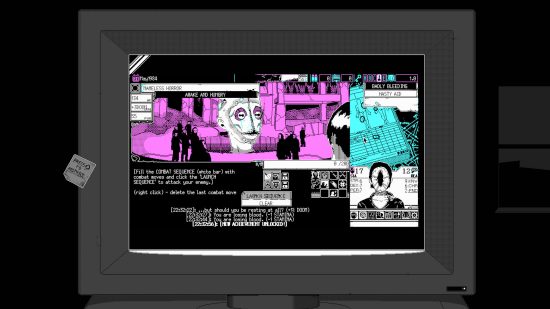Our Verdict
World of Horror is an ambitious and impressive little horror gem that reads as a love letter to the works of Junji Ito and Lovecraft. Revolving around gorgeous retro vibes, twisted tales, and RNG-fuelled gameplay loops, it’s a morbidly moreish experience that’s hard to put down.
As a massive (near obsessive) Junji Ito fan and admirer of cosmic horror, it’s no surprise that I’ve been keeping a close eye on World of Horror since it initially entered early access back in February 2020. As such, it almost feels cathartic to finally sit down to write this World of Horror review for the full release in the midst of spooky season over three years later.
This unique experience takes heavy inspiration from the iconic works of Ito, with a splash of Lovecraft thrown in via the apocalyptic themes and Eldritch ‘old gods’. But, if you think this is going to be a simple visual novel with some jumpscares sprinkled in, you’d be sorely mistaken. It’s a mixing pot of gameplay elements, combining roguelite, RPG, text-based adventure, and, to some degree, visual novel, into a beautiful Frankenstein-esque monster, all encapsulated in a retro 1-bit (or 2-bit) package with a ‘80s-’90s-style UI. If that sounds wild, that’s because it is – but I promise, it really works.
World of Horror’s main story mode, Extracurricular Activities, sees you take the role of a protagonist living in the coastal town of Shiokawa, Japan. Each playthrough begins with the summoning of an old god, which results in many unusual occurrences happening around the town.
You’re tasked with investigating five randomly selected mysteries, each of which has multiple endings – though these endings rarely change much beyond the final text screen. The mysteries are reminiscent of Junji Ito’s short stories without being derivative, each taking their inspirations and shaping them into something unique. The result is a series of evocative and tantalizing tales that capture the essence of Ito very well, reading like a love letter to the master of horror that we’ve all come to adore.
While there’s some deviation from the standard format in mysteries like Vicious Verses of a Violent Vigil, the main bread-and-butter of most investigations revolves around you investigating specific locations to uncover information and progress through the story. There’s also a side quest for each of these types of missions, which usually revolves around you investigating a separate location twice, or sometimes discarding two items. These generally provide you with a bit of extra information which may either make the final stages of your investigation easier, or allow you to get a different ending entirely.
There’s also the doom counter to keep in mind. Without modifiers, the doom counter varies by a set percentage whenever you perform an action, there are certain events or decisions you can make that will increase your doom level even further, and some that decrease your doom level. If you hit 100% or higher doom, it’s game over, and the old god wins. There is also a heap of modifiers that can make your doom level increase faster, such as town status effects, casting spells, or having a curse on your character.
Investigating locations results in randomized events. These come in a variety of forms, including battles with one of the many enemies in the game, and multiple choice situations. Generally, the multiple-choice situations either rely on you having a specific item in your inventory, or you passing a certain stat check.
Stats in World of Horror feel very text-based RPG or DnD-like. You have your main stats, stamina and reason, which essentially act as your health bar – if you run out of either, it’s game over. On the other hand, you have the secondary stats like knowledge, perception, charisma, etc. These increase your chances of passing the stat checks in the randomized events, and can also influence other elements of the game, such as your ability to convince companions to join you.
Combat is turn-based, with an action bar that makes up your turn. You can fill this action bar with – you guessed it – different actions, including attacking with your weapon (with each weapon having its own damage, speed, and chance to hit), preparing to attack (which guarantees the attack will hit, regardless of chance), getting your allies to attack, and restorative actions. Outside of these sequences, you can use or throw items and cast spells without using any of your action bar.
Overall, it’s a pretty simple system, and it becomes even more instinctual when you learn what each of the icons means. It does, however, sometimes require some tactical thinking, be it working out what will take down your enemy quicker, balancing your stamina and reason through restorative actions, or working out what sequence of bows and claps will dispel a ghost. Combat can also result in curses or injuries, the latter of which you generally need to go to the hospital to cure, otherwise their effects only get worse over time.
While investigating, you gain EXP. When you hit 100 EXP, you can choose one of three random perk cards. These come with both a title that can help you in certain events, and a stat boost or benefit. For example, the Art Knowledge perk grants you +1 perception but also allows you to decipher artwork in an event rather than getting spooked. In addition to the perk card, you can also choose one stat to increase. This all adds a nice level of depth to your playthrough – though it often leaves you kicking yourself for overlooking one perk when you find you need it later.
As you can likely tell by now, World of Horror is, above all, an RNG-based game. While the customizable playthrough option gives you a little more control over the start of your game (i.e., you can choose which Eldritch god you’re going against, which character you play as, what ‘background’ your character has), and you can reroll which mysteries you’re investigating at the start of any story mode playthrough, pretty much everything else is more at the mercy of the RNG gods than the Eldritch ones.
This randomized nature does come with its frustrations – there are quite a few achievements that unlock handy things, and a lot of these are tied to factors such as you completing specific events with certain items in your inventory, fighting specific types of enemies a certain number of times, or equipping specific equipment during certain investigations. Even the items in the shops around town are randomized, and rerolling them increases your doom level. And, if there are one or two events you’re yet to play after having completed everything else, good luck – it may take you hours and many playthroughs before you finally get them.
It can also, if you’ll excuse the pun, doom some playthroughs from the out. You may get the worst events, town status updates, and a heap of curses placed upon you relatively early in the game, and by that point, there’s no real way to save yourself. Your character has multiple ailments that consistently nerf their stats but you don’t have the funds to see a doctor? Your doom level has hit 70% before the end of the first mystery? Well, it’s a choice of starting over, or simply waiting for your Eldritch pal to destroy you, at that point.
However, on the positive side, it does add a lot of replayability to the game. I’ve lost count of how many playthroughs I’ve completed since getting my paws on World of Horror, both in the ‘Extracurricular Activities’ story mode, and in the custom mode, and I can honestly say that no two playthroughs have been exactly the same, even when investigating a similar set of mysteries, or encountering some of the same events.
The game still continues to surprise me and bring new experiences my way, even after gathering most of the achievements, and I absolutely love that – especially as I continue to unlock gods, items, characters, and more. And don’t worry if you’ve already played through the early access version, as there appears to be new content in the full release, as well.
Outside of the main story mode and custom play, there’s also the Spine-Chilling Story of School Scissors, which is essentially a one-off investigation to introduce you to the game (you can, of course, also get this mystery in the full playthroughs). Then there’s quick play, which starts a new playthrough with a randomly selected character, old god, background, and more. And, finally, there’s the challenges mode which, unsurprisingly, sees you take on a selection of challenges, with special rules to spice up your playthrough.
Beyond the gameplay, you can also customize the appearance of the game. At its base, World of Horror’s visuals are entirely 1-bit and rendered in black and white (fun fact: developer Paweł Koźmiński designed all in-game artwork in MS Paint, which is absolutely mind-boggling considering how beautiful everything looks). But from the menu or at the start of a playthrough, you get the choice to switch between 1-bit or 2-bit, with the latter of the two adding a bit more depth and shading, as well as the choice of a wide range of different color profiles.
As you can likely tell from the images in this review, my personal favorite is the black, white, blue, and pink palette that adds a sort of pop art vibe, but there are some great options to choose from. The artwork overall is gorgeous, with some brilliant enemy and environmental designs that truly capture the essence of Ito’s iconic art style and high attention to detail, which is a truly impressive feat for the format and tools used.
In terms of sound design, it shows a brilliant level of attention to detail and dedication to maintaining that retro feel. From the blaring motherboard beep that plays when you launch the game, to the crispy .midi-style yell that sounds out when you choose a character, all the way through to the electronic soundtrack, it all adds to the vibe. You don’t get full voice acting or the bone-chilling Colin Stetson soundtrack of the upcoming Uzumaki anime here, but trust me, you don’t need it. Everything fits cohesively together, and does a brilliant job of emulating that almost analog-horror-esque vibe of booting up a chunky ‘90s PC, and I love it.
When it comes to performance, unfortunately I was only able to get my hands on a Steam key for this one, so I can’t speak to how it works on other platforms. But, considering its effective simplicity, I can’t imagine it’s going to struggle or stutter just about anywhere.
I’ve also played a couple of rounds on my Steam Deck, but the only problem I encountered there was not fixing the aspect ratio on launch – there’s no resolution option here, just a funky, retro window that pops up with the option to choose between 1:1, 2:1, or 3:1 scale, and on the Steam Deck, 3:1 results in half of the text stretching beyond the screen – but that was a quick fix, and aside from that it was all dandy.
I do hope that the Switch version has touchscreen controls, as the game does require some clicking around at times and I always find that to be a bit of a chore with an analog stick, but beyond that, I’m pretty sure you’re going to have a great experience regardless of what platform you choose.
However, there is one benefit to the PC version that I imagine the console ports will lack, and that’s modding. I’ve not fully explored the vast array of content out there yet, but there appears to be an amazing level of dedication to modding this little gem, with a heap of amazing experiences available through the World of Horror Discord. But, as is often the case with modding, in order to get them working you need to first fiddle around with the game files. There is a mod option in the menu where you can access any mods you’ve added to the files, and, who knows, perhaps there will be supported mods available on console in the future via this menu – but if you’re hoping to expand your game and explore all of these fantastic features, you may want to choose the PC version.
Overall, World of Horror is a very enjoyable game that offers plenty of unique experiences and offers a lot of replay value. Its aesthetic, vibes, and atmosphere are on point, and its reverent approach to the source material that inspires it makes it read as a unique love letter that still manages to maintain its own unique identity. Just like pawing through Ito’s Masterpiece Collection for the thousandth time, I feel as though I’ve come to love each playthrough more than the last, and if that isn’t a testament to the otherworldly horrors this game has to offer, I don’t know what is.
Well, my doom counter is rising to dangerously high levels, so I guess I’d better sign out here. But, if you’re interested in hunting down more spooks, be sure to check out our list of the best horror games and my feature on why indie horror games are so great, or head on over to our FNAF games and Poppy Playtime characters guides. Or, if you fancy staying on the Ito train, check out my rambling on our sister site, The Digital Fix, to read about why I think Crunchyroll’s Junji Ito anime kinda sucked, and that we all should’ve just waited for the Uzumaki release date instead.
